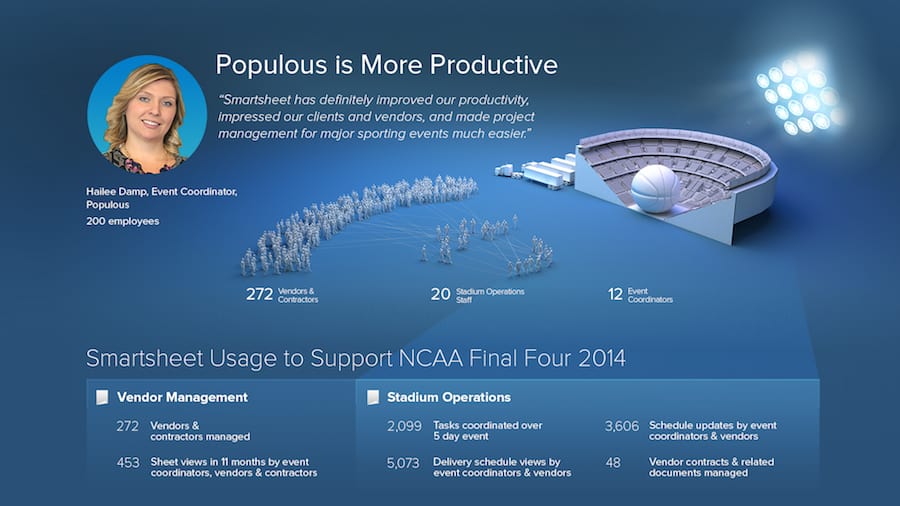How to Choose Event Planning Software
10 Key Features to Look for When Picking Event Planning Software
Before picking an event planning software, take some time to think about all the aspects of the events you’re planning.
Next, outline your goals for the event and ask yourself some questions: Does the software need to handle registration and transactions? Will you be using it to handle booth planning? Do people inside and outside of your organization need to access your materials? Taking the time to ask yourself these initial questions will help you prioritize your list of “must have” and “nice to have” features.
Finally, consider your industry. There are event planning software options designed specifically for people in verticals like government, non-profit, academic, trade shows, and more. Each industry may have slightly different needs, but valuable event planning software will offer a healthy amount of customization.
To help you with the process, we’ve created a list of features to look for when choosing event planning software:
1. Collect Information with Customizable Registration Forms
Registration features should be one of the first things to consider. After all, what’s an event without attendees?
“Always make sure that the person attending the event has an easy registration process with appropriate information shared with them after they have registered,” says Public Good’s Culley-Foster.
Look for a solution that offers robust online registration. You should be able to customize the type of data you collect and provide a registration code or unique ID for each attendee. If you’re doing an event that has multi-sessions, the event planning software should let attendees sign up for different tracks and then automatically generate session attendee rosters.
Registration is one of the first encounters potential attendees will have at your event, so branding and ease of use is imperative. Consider a product that has registration page templates that you can easily customize. If you do the same type of event multiple times a year, be sure you can duplicate and update a past event registration page to save you time in the long run.
2. External Collaboration and Communication Tools
You're going to work with many external collaborators when planning your event -- photographers, caterers, A/V equipment experts, on-site staff, guest speakers, talent, and more.
Stay organized by keeping track of all vendor and speaker information in one central location. Look for a solution where you can easily add contact information, assign tasks, create automatic reminders, and track emails and messages. Having all of that in one place will keep everyone on schedule.
You and external team members also be able to upload files like invoices, scope of work, maps, and diagrams to your event planning software regardless of the device you’re using. This creates a single spot for everything regarding that person.
If you plan on having a speaker, your event planning software should also help with scheduling them to speak at the event. Speakers will also have their own collateral information that you may need to manage, so look for a tool that can easily store and organize all documents. If you don’t want to be responsible for creating this information, choose event planning software that allows the speakers to upload their data themselves.
3. Automate Event Planning Workflow with Online Tools
When planning a large event, there are a lot of tasks that need to be completed by multiple departments. Your event planning software should simplify the process and keep you organized.
Look for a solution that allows you to schedule meetings, create, track and designate tasks, automatically send event emails, assign approval rights, and send automatic alerts to you if tasks fall behind. Extra collaboration features like comments and discussions help expedite communication.
4. Create and Monitor the Event Budget
One of the first things event planners do is determine a budget. Many event planning software products include a variety of budgeting tools and financial reports. More robust features include the ability to track revenue and the cost of items, and provide tools to help determine ROI.
For example, some tools let you build budgets based on fixed costs and variable costs per attendee so you can analyze the average cost per person. If there are multiple business units involved, pick an event planning software that lets you calculate each unit’s costs individually.
New event planners should look for software that has templates with pre-created calculations. The templates should be customizable and provide an overview of the target budget, actual cost, paid to date, and balance due.
5. Generate Buzz with Incorporated Event Marketing Features
When it comes to marketing features, you definitely want something that offers more than traditional email campaigns. Many event planning software packages include the tools needed to create an event website and registration page. If you don’t have access to design resources, this option could be a great way to get started with little stress. Just be sure the editing tools will let you make the changes you want.
For events with multiple sponsors, ensure that there are plenty of customizable ways to highlight them when needed. For example, you might be using the event planning software to create polls. If that’s the case, that could be a chance to sell more sponsorship opportunities.
Another way to build awareness is to use social media. Choose a tool that lets people easily follow and share your event site content on sites like Facebook, Twitter, LinkedIn, and Google+. Some software will even let you boost some of your social shares. The software should also have the ability to generate a QR code, so people using their mobile phones can quickly access your site without having to type in a URL.
And the marketing doesn’t stop there.
“Planning an event is like climbing a mountain; getting to the peak is actually the halfway point, you still have to climb down the mountain afterwards. Events are the same way, a lot of preparation goes into the event, there's a celebration during it, but what you do after it can make all the difference,” says Culley-Foster.
With that in mind, the event planning software you choose should also be able to generate lists of people who attended as well as create and send out follow-up surveys. Once the surveys are complete, use the software to run reports to help judge things like session engagement and overall success.
6. Create Customizable Reports from Event Data
Reports are an effective way to determine the ultimate success of your event. Pick event planning software that can automatically run the reports that you need. Many offer hundreds of reports, but you may only need a few. Some of the more common types of reports are financial summaries, inventory status, attendee or exhibitor tracker, multiple event comparisons, email marketing, and survey stats.
You should also have the option to create branded custom reports where you define specific categories (event type, region, etc.) so you can determine things like ROI. Be sure to choose a solution that lets you export reports in your preferred format (Excel, PDF, CSV, TIFF, PowerPoint, or Web).
7. Store Event Planning Documentation and Communication in a Central Location
There are dozens of documents, reports, images, emails, and more that get created when planning an event. To streamline communication and organization, store all these files in one central location for people to access at any time.
Look for a solution that lets you set sharing permissions and that provides free access to the documents to outside vendors. It should also have the ability to attach documents and other materials from Google Drive, Dropbox, Box, and other apps. A web-based event planning solution would also allow you to access all of your event planning data on multiple platforms, thereby eliminating compatibility issues.
8. Automatically Create Gantt Charts
A great way to visually track your event is with a Gantt chart.
Another benefit of Gantt charts is that it gets you thinking about all the tasks that need to be accomplished. By creating the initial task list, you can use the Gantt chart to clearly see which tasks are dependent on others.
Some popular Gantt chart features include using predecessor tasks to create dependencies, labeling and defining bar colors, adding milestones, and the ability to share it with collaborators and team members.
9. Leverage Built-in Mobile Support for You and Your Event Site
Your event planning software must be compatible on mobile. Some tools even include a way to easily create a registration and event site on mobile. To ensure the site will work seamlessly on a mobile browser, check to see that it’s using responsive design. In addition to a mobile site, some providers include mobile apps for attendees as an option.
Mobile support isn’t just for the attendees; it’s also an important feature for you. Planning an event will take you out of the office and you will likely need access to your files. Be sure the software you pick will work on the smartphones and tablets that you and your team use regularly.
10. Research Pricing and Know What’s Available
Pricing for event planning software can vary, based on the offering.
Some companies offer packages that cost a monthly fee and pricing goes up based on the amount of events you’re planning. If you do opt for cloud-based event planning software, be sure to find out how much storage you’ll receive. Always ask if there is a limit to the amount of people who can use the software.
Registration volume is also a method some companies use to determine pricing. This can be billed as a monthly or annual fee depending on the company. If you pick an option with this pricing structure, ask if there are discounts when you hit a specific number of registrants. You should also ask about software discounts if you’re planning a non-profit event.
Don’t forget to find out what type of support is included (webinars, 24-hour online support, forms, online videos, etc.) and take advantage of free trials. Before you commit to any event planning tools, be sure to take them for a test drive first.
Use Smartsheet to Plan Your Next Event
Powerful Event Planning Software Success Stories
Organizing the 2014 NCAA Final Four
When you’re responsible for pulling off one of the biggest sporting events of the year, organization is essential. Populous, the company responsible for the 2014 NCAA Final Four, used Smartsheet to coordinate hundreds of people and thousands of details to successfully pull off the popular sporting event.
To help coordinate 272 vendors and manage dozens of workflows, the company needed a powerful collaboration tool that could be accessed by anyone, anywhere from virtually any device.
“We relied on over 200 vendors. Making sure others did their job was the only way we could succeed,” says Hailee Damp, Event Coordinator at Populous.
To learn more about how Populous used Smartsheet to organize the 2014 Final Four, read the case study here.
Planning Cross-Country Tours
To honor the 20th anniversary of the United States Holocaust Memorial Museum in 2012, the internal event team was tasked with organizing and managing a tour that included more than 20 events. The teams would need to develop hundreds of new pieces of collateral, signage, sets, and staging for the events. Their existing tools just weren’t up to the task.
Christine Sonnabend, lead project manager, explains. “Our project management process was anything but streamlined. All departments were requesting assets from the marketing team via every channel imaginable. It was nearly impossible to get an accurate status update. We simply weren’t in a position to pull off the 20th Anniversary Tour unless we found a better way to manage deliverables – from intake to finish."
Former President Bill Clinton and Museum Founding Chairman Elie Wiesel keynoted on the final day of the national tour.
The Museum turned to Smartsheet to provide a centralized location to store all documents, tasks, and marketing assets for the multiple events. The online collaboration tools were instrumental in ensuring no details fell through the cracks.
Increase Event Success with Real-Time Planning in Smartsheet
The best marketing teams know the importance of effective campaign management, consistent creative operations, and powerful event logistics -- and Smartsheet helps you deliver on all three so you can be more effective and achieve more.
The Smartsheet platform makes it easy to plan, capture, manage, and report on work from anywhere, helping your team be more effective and get more done. Report on key metrics and get real-time visibility into work as it happens with roll-up reports, dashboards, and automated workflows built to keep your team connected and informed.
When teams have clarity into the work getting done, there’s no telling how much more they can accomplish in the same amount of time. Try Smartsheet for free, today.





